Oldfield Park Junior School WW1 Memorial:
The Research Project

The Beginning
Early in 2013 I was contacted by a friend whose children attend Oldfield Park Junior School. She asked whether I had any literature or sources of information that could be helpful for a local history project being planned by the school and which her children were due to work on. I supplied a couple of old maps that clearly showed how Oldfield Park had grown as a conurbation in the late 19th century and also a few photographs of my Auntie Betty in class photographs in the 1920s and 1930s while at the school, when it had been known as South Twerton School. I also offered to support the school if they thought I could be of help with the project in any way. Within a few weeks, I was up at the school, meeting the Head, Ms Cole, and the Humanities Lead, Mrs Jenner.
Ms Cole showed me the striking marble plaque in what was then called the Blue Hall, which commemorates the 33 fallen servicemen who lost their lives in the First World War and who had a previous connection with South Twerton School.
Ms Cole asked whether I was keen to help with some research into the people behind the names. I was. This website is the result of what we found.
Oldfield Park in its Infancy
From a local history point of view, a key part of the research was the realisation that the period in which the named lads attended South Twerton School was the very beginning of what we now know as Oldfield Park. Anyone turning eighteen around 1914 would have been born in the period when Oldfield Park was being built and the servicemen listed on the plaque would have been among the first pupils through the doors of the 1897 school. The area now known as Oldfield Park was built to fill the space between the previously distinct entities of Twerton and Bath. Each was building towards the other, converging on the parish boundary that – prior to Twerton being subsumed into Bath in 1909 – was of much greater significance than it is today. The spread of Bath westwards from the Upper & Lower Oldfield Park area was known as ‘Oldfield Park’. The eastward extension of Twerton towards Bath was known (north of the GWR line) as East Twerton and (south of the GWR line) as South Twerton.
The inclusion of details of the wider family of the fallen servicemen is therefore intended to illustrate whence the earliest inhabitants of Oldfield Park came. The types of employment taken up by many of the men-folk on their arrival in the area speak volumes of the effects of the forces that inexorably drew people from rural areas into the growing cities at that time. We do not often think of Bath in terms of the effect of the industrial revolution, but the history and development of Oldfield Park is inextricably linked with the rise of Stothert & Pitt, the Pitman Press, Bath Cabinet Makers etc. and their need for manpower.
Genealogical Research
As such, I was motivated to look at who the parents of the fallen servicemen were and to understand where they had come from, in addition to studying the servicemen themselves. Hence each individual history on this site begins with a look at the parents and their route to Bath. This requires a degree of skill in genealogical research that I do not possess, although my own family history is of great interest to me. Fortunately, past attempts to research my paternal grandmother’s family – the Nixey family – have led me to a man called Jon Nixey. Jon is my third cousin and an absolutely amazing genealogist. His ability to track down lost connections, notice key details in the data and apply multiple layers of logic to the analysis of the facts is incredible. He is also doggedly determined. It is unsurprising that he has earned the nickname ‘Sherlock’ among those who come into contact with him when he is wearing his genealogy hat. Throughout the research into the 33 names, I have attempted to play a passable Dr Watson, while marvelling at the work of the master!
Jon is also descended from the Bath branch of the Nixey family, but his forebears headed west in search of work in the coal mines of South Wales. Jon lives in Abertillery, but has been as enthusiastic about this project as I have. I am very grateful to him.
The Task
The aim was to support Oldfield Park Junior
School pupils in finding out what each serviceman's life had been like prior to
and during WW1. We wanted to know as much as possible about these men,
that they might be remembered in specific terms, rather than simply as
abstract names on a plaque.
Fortunately, most of the names on the South Twerton memorial plaque are relatively less common surnames, even bearing in mind names such as Gould and Billett that seem to be focused locally. Even the maiden names of the subjects’ mothers did not throw up anything too common. This aided the research somewhat, but still provided challenges that, when overcome, have provided real ‘Wow!’ moments. Equally, to see documents, newspaper reports and, in some cases, photographs that take us straight back to the lives of the 33 named servicemen, has been a truly amazing experience for the amateur local historian.
One of the difficulties of the project overall has been knowing how to refer to the 33 men. ‘Ex-pupils’ or ‘Old Boys’ will not do, as research quickly showed that they were not all scholars at South Twerton; George Strong was a trainee teacher at South Twerton and later became Headmaster of St Saviour’s in Larkhall. Neither were they all soldiers, as two served with the Royal Navy and died at sea. I have settled on 'servicemen'.
The First World War
A key part of the research was clearly to understand what each of the named men did in the War. Which unit did they serve with? What did this unit do? Where did it go and when? What were the circumstances in which each of the South Twertonites died? With no background in First World War history, nor in military matters, the barrage of terminology was initially quite difficult. I had heard of the words ‘battalion’, ‘platoon’, ‘army’, ‘division’, squadron’, ‘regiment, ‘company’ and so on, but had no understanding of their actual meaning or interconnection. The same was true of the ranks and titles. All I can say is that I now have a somewhat better grasp of these matters than I did when I started!
All in all, however, I feel extremely grateful that this project has given me the impetus to actually read about the First World War. Until I did, many of the notions that I had of trench warfare and the privations of the soldiers’ existence in France and Belgium were extremely vague. I also had no idea that the First World War had not just taken men from Oldfield Park to the Western Front, but also to the South Atlantic and to Africa and to Greece. I am grateful for the fact that my awareness of the issues and circumstances that shaped the lives and deaths of so many men and women during the First World War has been significantly raised in advance of the many commemorative events and programs that will form part of public life in the next few years.
For anyone who wishes to gain a good understanding of events in WW1, I would heartily recommend the following Imperial War Museum books by Malcolm Brown, which are not hard to read and allow the layman some insight and understanding into what was a hugely complex war.

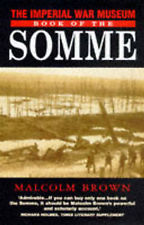
Oldfield Park Junior School Project
I was able to witness the school’s Remembrance Day Assembly on 11th November 2013, at which the 33 names were read out by Ms Cole, with pupils placing poppies into a prepared wreath, which was then hung beneath the memorial itself. This was very moving and signalled the start of the school-wide project.
The project saw pupils conducting research into the 33 servicemen's histories and learning more about WW1 itself.
The way the school has put the WW1 project at the heart of its activities has been amazing; it has been incorporated into many different types of lessons and resulted in some fantastic work by the pupils, including written work, artwork, music & PE. Pupils have learned research skills and familiarised themselves with online and physical research resources.I had the pleasure of working with some of the pupils and hearing from them at first hand about the aspects of the research into their WW1 memorial plaque that interested them most. Staff at OPJS have been extremely friendly, helpful and enthusiastic. Most importantly, pupils have learned how WW1 affected their community one hundred years ago, making the wider WW1 centenary commemoration much more relevant and immediate to them.
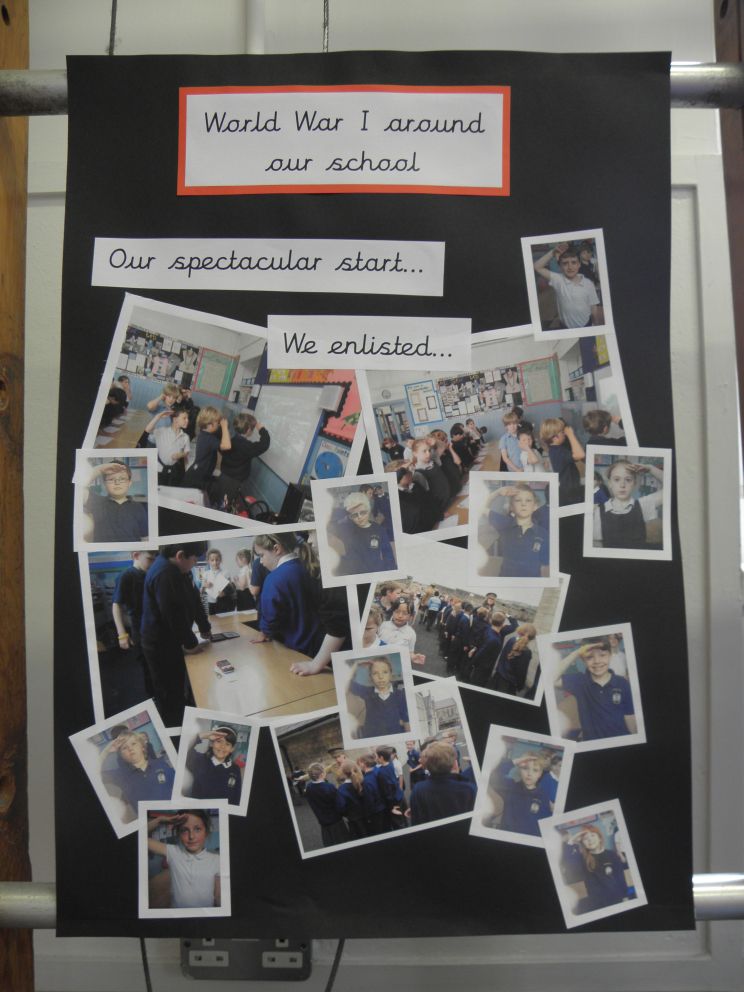
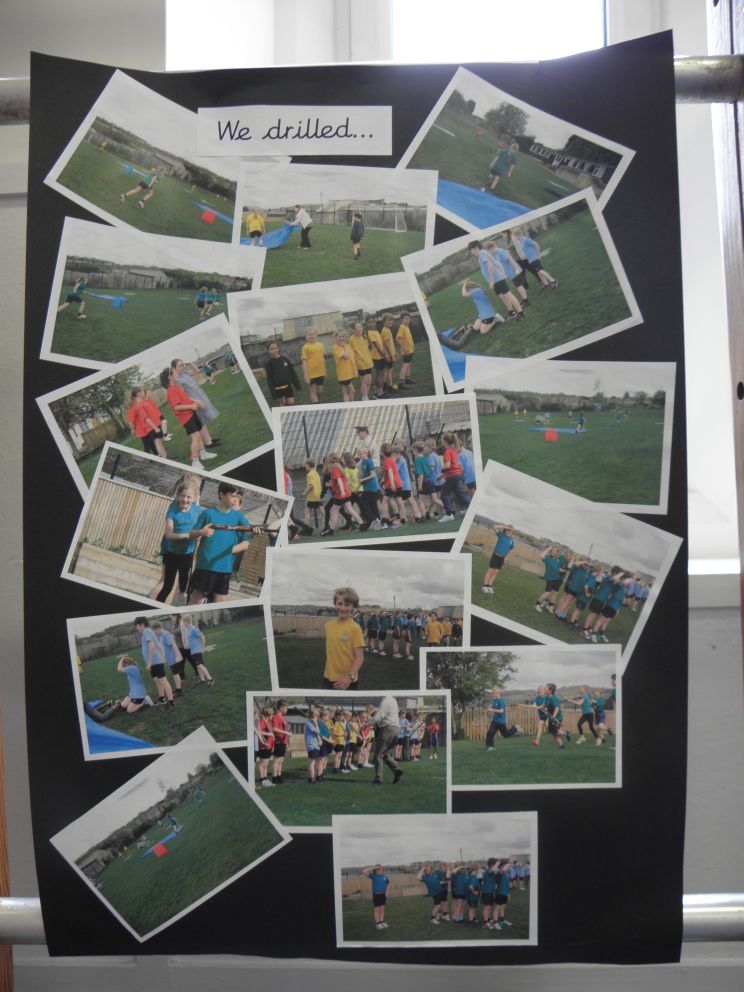

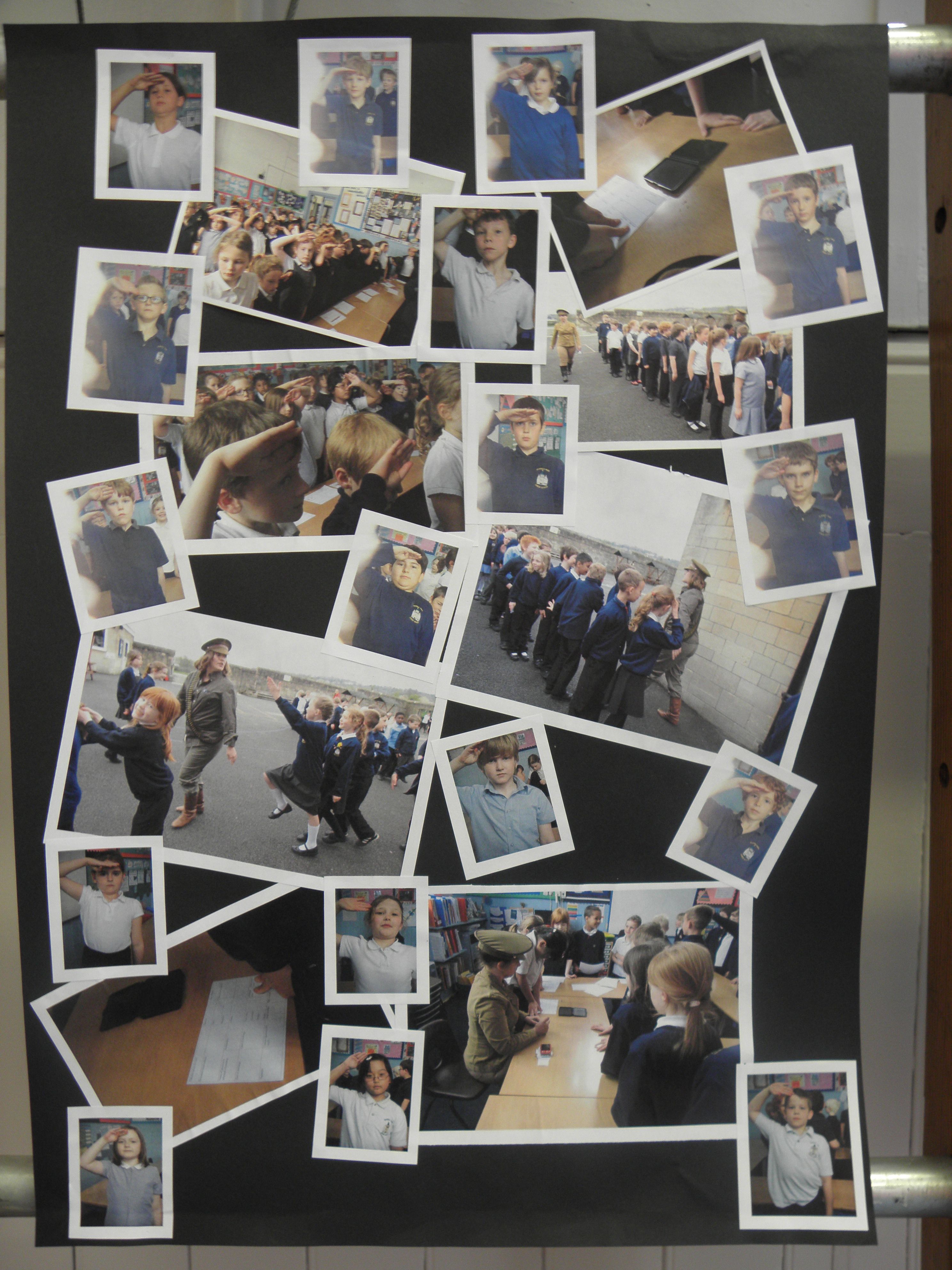
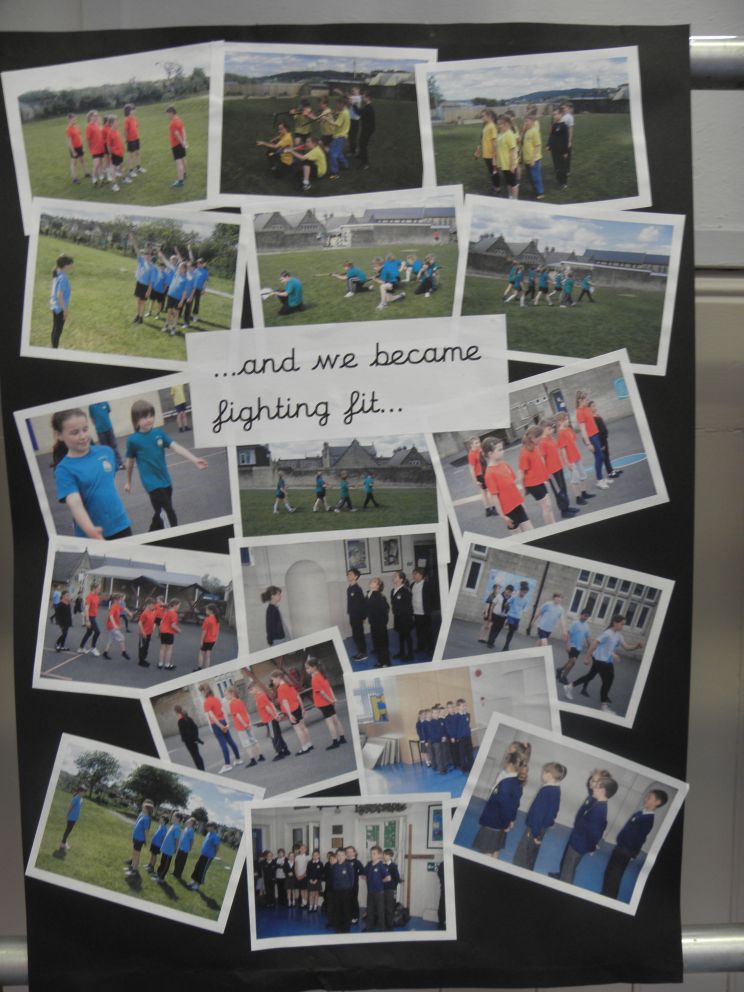

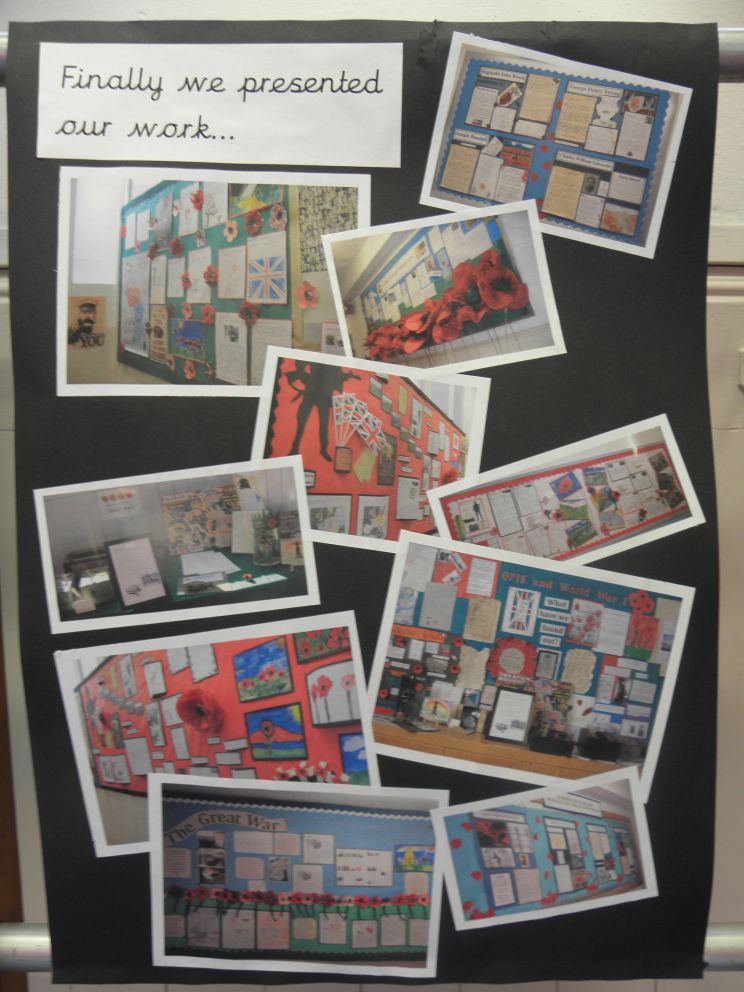
I look forward to supporting the school with making the most of this research in the years to come.
Public Exhibition, July 2015
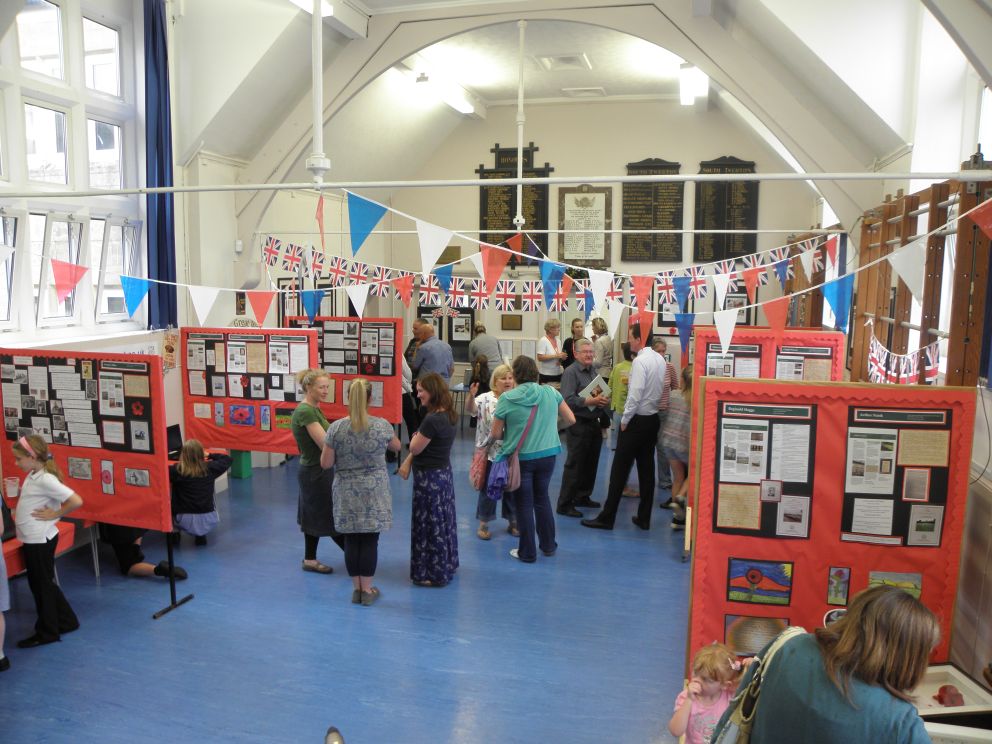
The culmination of the school project was a public exhibition at the end of the 2015 summer term, primarily showcasing the pupils' work in commemoration of the 33 servicemen on the school memorial. This took place in the hall where the memorial is displayed. The event was open to parents and members of the community, with special guests including relatives of three of the commemorated servicemen.
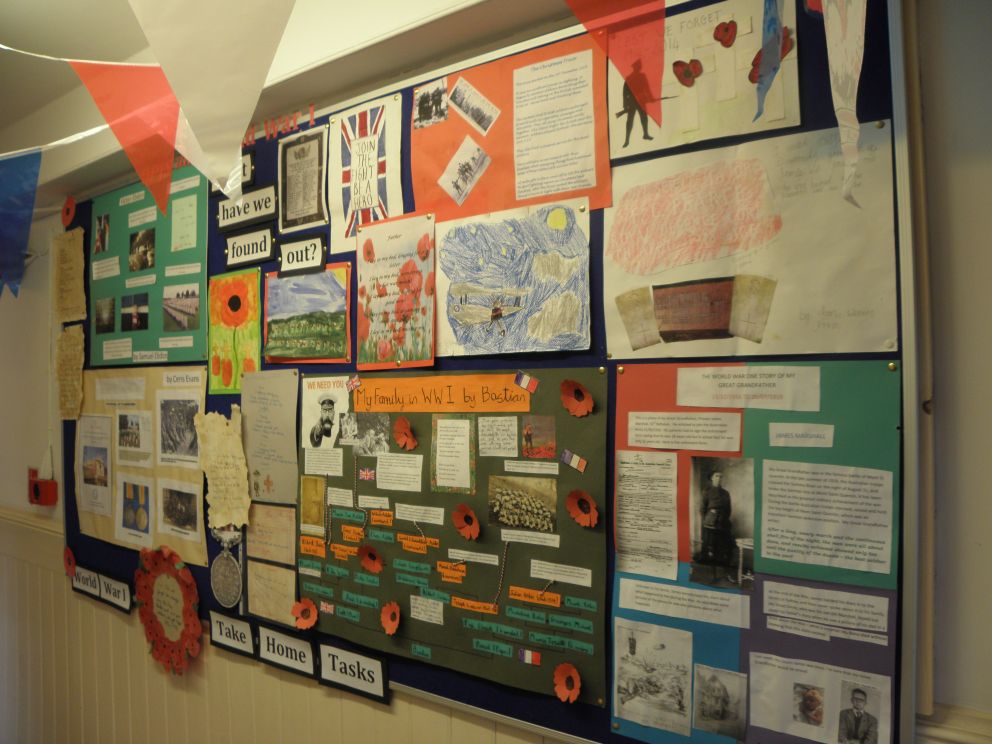
Display board in the corridor leading to the hall
The exhibition also included a valedictory for the departing Head Teacher, Marilyn Cole, who had instigated the school project and who spoke to pay tribute to the energy and enthusiasm that staff and pupils had brought to the project. Ms. Cole then presented the school with one of the ceramic poppies from the 'Poppies in the Moat' installation at the Tower of London as a parting gift to the school.
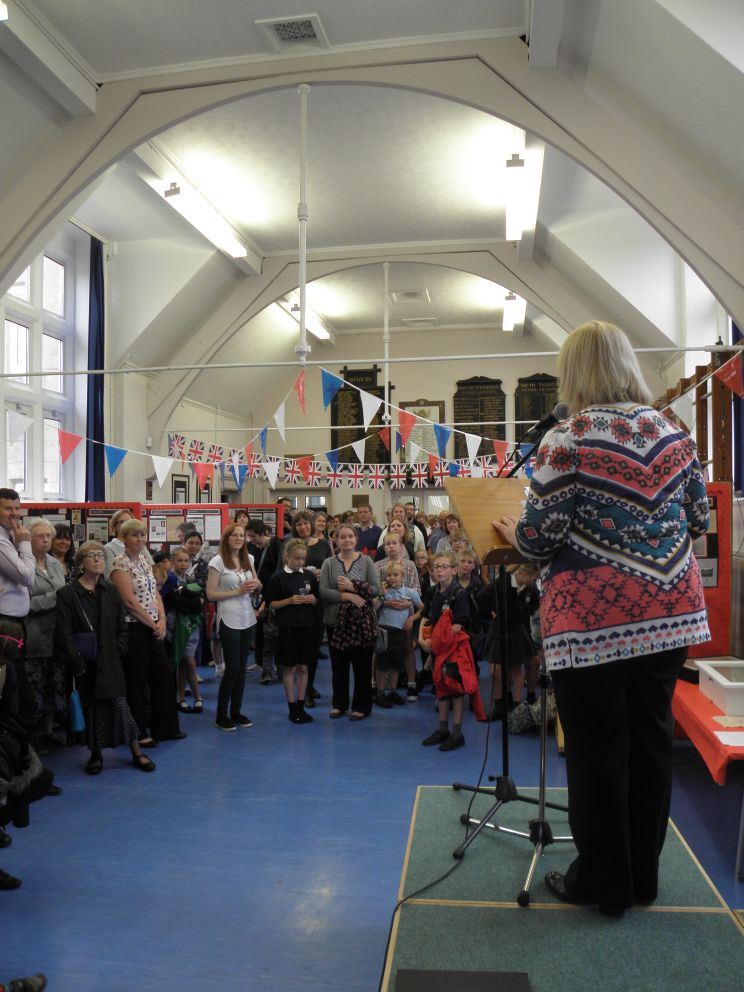
Ms. Cole addressing visitors to the exhibition


Commemorating the end of WW1 in 2018
The school again conducted themed activities across the curriculum in November 2018, to mark the centenary of the end of WW1. This culminated in a special Remembrance Assembly in the Church of the Ascension, which saw many OPJS schoolchildren making a very special contribution to the school's act of remembrance in the presence of relatives of the school's Fallen, as well as school staff, parents and friends. The service included readings of written work, sung pieces from the choir and other pupils, a moving 'Last Post' on the clarinet, as well as individual remembrance of the school's 33 Fallen servicemen.
Between the commemorations of 2014/15 and 2018, the school has brought meaning to the act of Remembrance for several hundred children which will hopefully remain with them for life. As the Head, David Goucher, commented in his closing remarks in the 2018 service, the attitude of the pupils to the whole subject matter does indicate that the future of Remembrance is safe with the next generation.
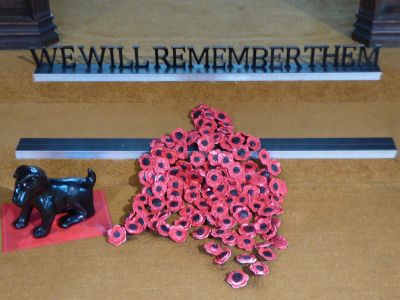
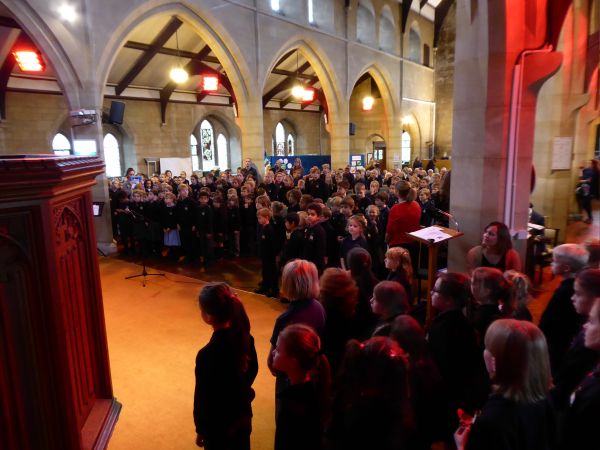
The closing chorus of 'Pipes of Peace', sung by the whole school.
We were particularly pleased to welcome to the 2018 proceedings some family members of the school's Fallen, who were impressed by the dedication of the school and the individual pupils in actively remembering their lost relatives one hundred years after the end of WW1.
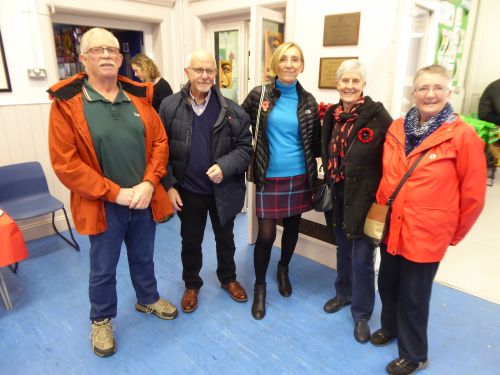
Above: L-R: Rob Gould, Mike Sumsion (who has visited graves of several of the school's Fallen on the Western Front), Ruth Gould (relative of Ernest West), Kathy Sumsion and Rose Harvey (relative of Joseph Randall).
Below: Shelagh Padfield and Malcolm Curran, niece and nephew respectively of Reginald Maggs.
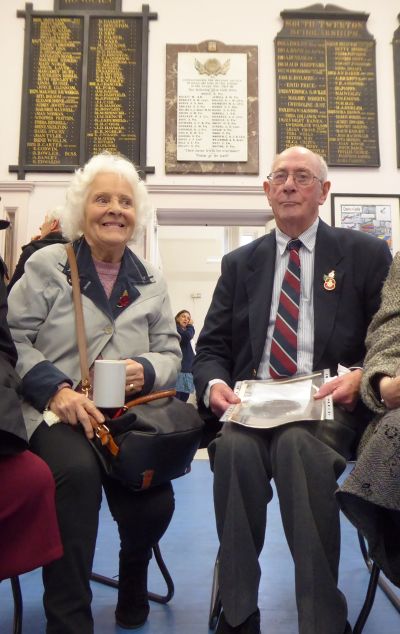
Hopes
Our hope is that these pages will serve as a permanent reminder of the 33 men who at one time or another walked the same streets of Oldfield Park and lived in the same houses that pupils of Oldfield Park Junior School and their families do today. These men did not grow up expecting to die young in a foreign country (or at sea), but answered the call when it came and gave up literally everything in the belief that their sacrifice was for the benefit of future generations. Many also went through a fairly extreme form of living hell before they died. As a nation we have promised not to forget them and I hope this website helps with that aim.
We also hope that this project enhances the general understanding of Oldfield Park and its history, of which the characters which feature in these pages are a part. I particularly hope that the pupils of Oldfield Park Junior School will have learnt – perhaps partly through this project – that the history of the City of Bath does not begin and end with the Romans and the Georgians and that a significant share of the life, soul and history of the city is written and created by the people who live in the small houses.
We hope that any relatives of the fallen servicemen researching their family histories in years to come might be pleased to find out more about a long-forgotten relative who died in WW1 and whose memory will now be perpetuated in these pages.
We hope that others who happen across this site will be able to add to the story of the men commemorated here.
I hope and trust that the information given on this site is correct. It is the result of painstaking work and I have tried to avoid assumptions where possible in favour of hard facts. Please let me know of any inaccuracies or mistakes through the contact form.
Equally, I have collected many images, facts and documents in the course of this research and tried where possible to record where I found these. Where I cite text or show photographs from anywhere other than public sources, I have tried to credit these where the source is known. If I have omitted to do so in relation to specific material and you wish for either a credit or the removal of the material, please get in touch through the Contact page.
John Branston
